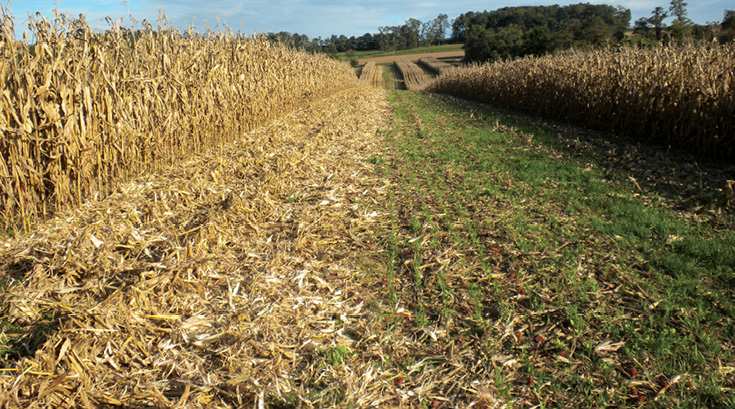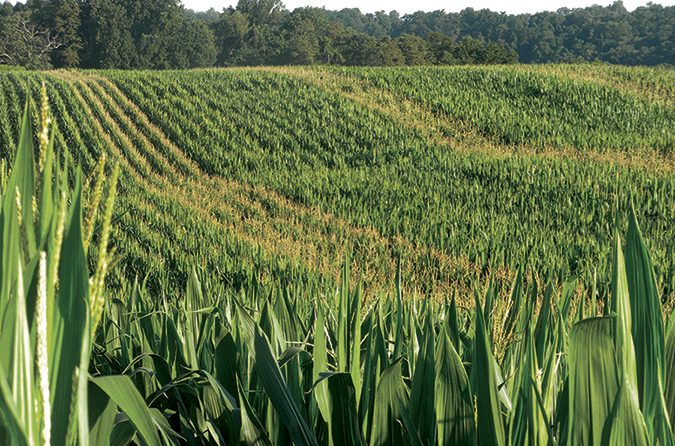One obstacle to cover-crop adoption in cooler northern climates has been the typically narrow window for getting covers quickly seeded and established after corn harvest to capture benefits to no-till soils.
But recent onfarm trials suggest the quality of short-season corn hybrids has vastly improved in the last decade. In fact, there may be an opportunity for no-tillers to harvest corn earlier — without losing yield, researchers say — and seed cover crops a few weeks earlier.
Both Penn State University researchers and Holtwood, Pa., no-tiller Steve Groff have found short-season corn yields have been competitive or even superior, in some situations, to longer-season hybrids. No-tillers could also benefit from crop pricing flexibility in addition to gaining the benefits of seeding cover crops.
Groff says corn growers could use earlier-maturing corn to spread out harvest and allow for easier management in terms of timing flexibility.
“I’m not saying no-tillers should do it on the whole farm,” he says. “This concept works together with cover cropping, because sometimes that window of time to seed is way too small and every day counts with cover crops.”
Higher Yields
Last year on Groff’s Cedar Meadow Farms in southeastern Pennsylvania, T.A. Seeds corn hybrids with maturities ranging from 83 to 111 days were planted between April 16 and April 25. All plantings were replicated three times in 30-inch rows of 500 to 1,000 feet.
Plant populations were 32,000 seeds an acre for each hybrid. Fields were fertilized according to need.
As the hybrids matured, Groff’s team harvested the corn at moisture levels of 15.5% to 20.8%. Following harvest, cover crops designed for a longer calendar period were seeded in hopes of duplicating what farmers would typically do in their fields.
In Field 1, early- and midseason hybrids harvested on Sept. 10 outyielded a long-season hybrid harvested Oct. 1.
The 83-day hybrid harvested at 15.5% moisture yielded an average of 207.4 bushels, much higher than a 107-day hybrid with a 178.5-bushel yield harvested at 19.2% moisture. A 95-day hybrid harvested at 16.5% moisture yielded 212.1 bushels.
At the harvesttime price of $8.40, the 83-day corn would have produced gross revenue of $1,742 an acre, much higher than the $1,388 an acre coming from 107-day corn harvested Oct. 1, when local prices dropped to $7.78.
In Field 5, a 97-day hybrid — harvested on Sept. 14 at 19.1% moisture — averaged 195.2 bushels an acre, which was higher than 111- and 108-day hybrids yielding 189.6 and 164.7 bushels, respectively, that were harvested at similar moisture levels.
During the growing season, moisture was adequate until mid-June, when it turned dry for 5 weeks. Adequate moisture returned in July.
“The first stage of this project is seeing if short-season varieties have validity, and last year, they did,” Groff says. “Part of it is weather related. Last year, we made more money with short-season corn that some experts said shouldn’t even be grown around here. In July we had rain, and the average farm yield was 155 bushels.”
After the fields were harvested, cover-crop mixes that included common and hairy vetch, crimson clover, Persian clover, annual ryegrass and triticale were seeded.
This spring, Groff planted those fields to a single corn hybrid based on the best date to plant. He’ll measure this fall what might have been gained by seeding the cover crops sooner.
In another field this spring, Groff repeated the early-corn experiment as a continuation of the 3-year project.
Groff noted last November that the cover-crop vegetation in earlier-seeded plots was 6 inches taller than plots planted the first week of October.
“But when we went through winter and came out in spring, the covers looked fairly even — like you couldn’t tell which plots were planted earlier,” he says.

Timing Counts
In some cases, harvesting corn earlier allows more options for selling, especially if delivery contracts can be inked before Midwestern corn harvest gets under way.
Last year on Groff’s farm, corn prices were $8.40 a bushel on Sept. 10 when the 83-day corn was taken off. By Oct. 1, prices had fallen to $7.78. They were down to $7.34 by Oct. 16.
Many Advantages
Penn State University researchers have also evaluated short-season corn hybrids as part of the university’s silage hybrid-testing program.
They found some valuable insights, although the trials weren’t designed specifically to test short vs. late hybrids, says Penn State agronomist Greg Roth.
In 2009, researchers compared 111- and 115-day hybrids to 116- to 120-day hybrids for silage near Holtwood.
They found only a modest yield bump, with the longer-season hybrids yielding 29 tons per acre compared to 30.5 tons for shorter hybrids.
In 2010, during a dry year, earlier hybrids yielded 17.4 tons compared to 17 tons with the later 115- to 120-day group.
An earlier test of 105- to 110-day hybrids yielded 17.5 tons per acre, Roth says.
In 2012, Penn State used two locations to compare earlier-maturing hybrids of 101 to 110 days to hybrids of 110 to 120 days.
One location yielded 27.2 tons for the early hybrid and 27.3 tons for the later hybrid, while the second site averaged 25.3 tons for the early group and 24.2 tons for the late group.
The comparisons usually had a dozen or more hybrids. Most received liquid in-row starter fertilizer and sidedress nitrogen applications, as well as fall or spring manure applications.
“I still feel later hybrids can have advantages in some environments,” Roth says, “but our recent data shows strong performances by early hybrids.
“That may cause farmers to consider using them for some acres where they want to seed cover crops or take advantage of local market needs.”
Roth cites several reasons for moving to shorter-season hybrids on some acres:
- The need for early silage, as feed inventories are often depleted by the end of summer in his area. Having some new crop to feed and ferment allows for earlier feeding in the fall, Roth says.
- Use cover crops for fall forage. “Dairy farms are relying more on spring oats and mixtures of spring oats, ryegrass and winter grains for fall supplemental forage,” he says. “By gaining an extra week or two in the fall, yields of these crops can be maximized.”
- Taking advantage of good price premiums, as Groff noted. “Our local corn supplies are exhausted in late summer and we often have a good basis,” Roth says. “Once harvest starts in earnest, mills can fill up and the basis drops. Grain producers can plant barley or wheat following an early corn hybrid and squeeze three crops into 2 years.”
- Reducing drought risk. “Sometimes early hybrids avoid droughts,” he says, “Other times, it’s the late-season hybrids that fare better.”
- Creating more soil-improvement opportunities for cover crops. Roth says many farmers in eastern Pennsylvania are believers in cover crops and want to create more opportunities for cover cropping with early-season hybrids.
“Planting covers earlier maximizes fall growth of many species, which they feel helps to alleviate soil physical issues, improves yields the following year and reduces nitrogen costs,” he says.






Post a comment
Report Abusive Comment